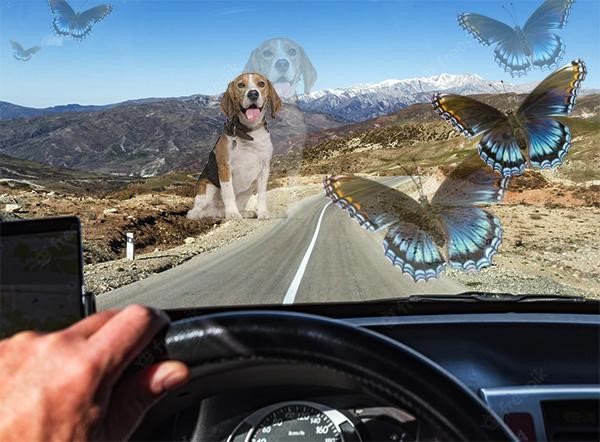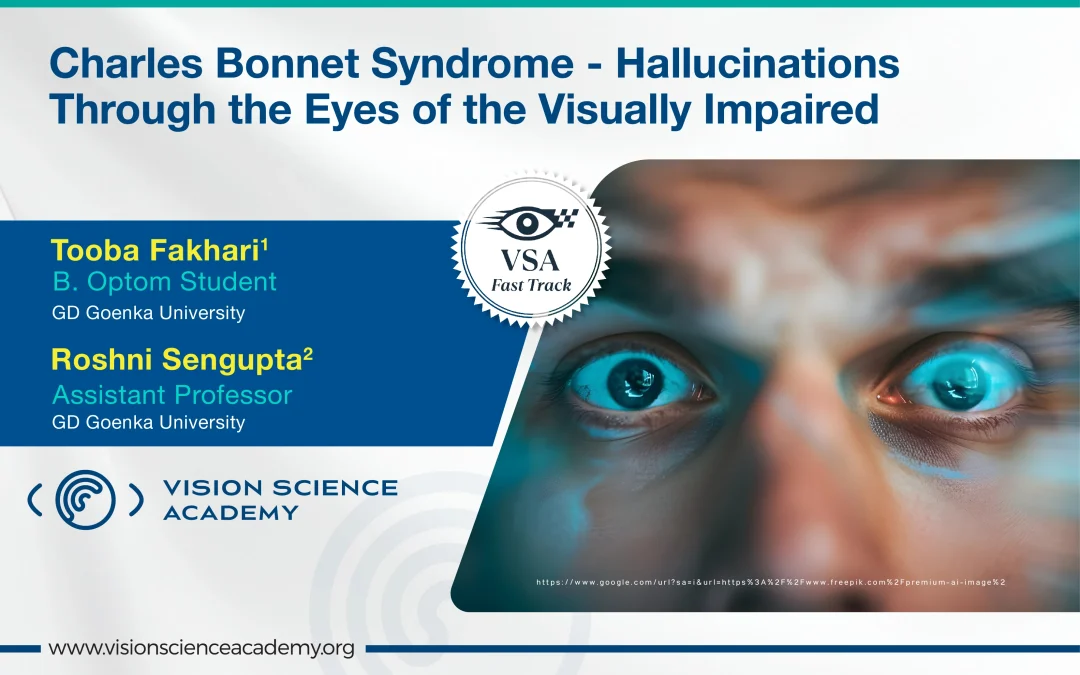Tooba Fakhari, B.Optom 1,
Roshni Sengupta, Assistant Professor2
1,2GD Goenka University, Gurugram, India
Charles Bonnet Syndrome (CBS), also referred to as visual release hallucinations, is a condition where individuals who have lost all or most of their sight start to perceive images that do not exist, even though they are not having any mental disability. First described by Swiss philosopher, Charles Bonnet, who documented his grandfather’s visual experiences in 1760, Charles Bonnet Syndrome (CBS) remains underrecognised despite its clinical importance. (1) Its relevance has grown with the rising global prevalence of visual impairment, driven by ageing populations and conditions such as Age-Related Macular Degeneration (AMD) and Diabetic Retinopathy. CBS is defined by the presence of visual hallucinations in individuals with significant vision loss, while cognitive function remains intact and no underlying psychiatric or neurological disorder is present. (2) The hallucinations are typically vivid, well-formed, and non-threatening, often including images of people, animals, or complex scenes (as shown in Figure 1). (3) There is no auditory or tactile component, distinguishing CBS from psychotic disorders. Diagnosis remains clinical, usually relying on the exclusion of psychiatric or neuro-degenerative pathology. (4) While hallucinations are usually not harmful, they can be distressing, affect quality of life, and sometimes be mistaken for signs of dementia or mental illness. (5) Risk factors include advanced age, bilateral visual loss, and social isolation. Among ocular diseases, AMD is the most associated condition, but CBS has also been reported in Glaucoma, Diabetic Retinopathy, and Optic Neuropathies. (6)

Figure 1: Phantom images seen in CBS
Why Does the Brain Create Vision Without Sight?
There are two most widely accepted theories explaining this syndrome:
First, the differentiation theory claims that loss of visual input leads to spontaneous activity in the visual association cortex, causing hallucinations. (1,7) Also, the social differentiation hypothesis states that social withdrawal can induce complex hallucinations resembling people to make up for the lack of social interaction. (8)
Second, the release theory proposes that lesions in the visual pathway generate abnormal signals, which, combined with residual normal input, activate the visual cortex and produce hallucinations. (9)
Research utilising functional MRI (f-MRI) has shown that hallucinations correlate with activation in the ventral visual stream, suggesting a cortical origin. (10)
Addressing Gaps and Guiding Care for CBS
Currently, there is no widely recognised treatment for CBS. Reassurance and patient education are the key strategies and are often enough to ease concerns. (6) Enhancing lighting, reducing social isolation, and using low-vision aids can sometimes help reduce the occurrence of hallucinations. Despite being documented for decades, CBS remains under-recognised in ophthalmology and general medicine. Greater awareness, better screening tools, and research on its neurobiology are crucial, along with integrating CBS into ophthalmology training and exploring non-pharmacological interventions.
Conclusion
CBS highlights the brain’s unique way of coping with vision loss. In many cases, visual rehabilitation and counselling prove to be more effective and better tolerated. By spreading awareness and offering support, we can replace fear with understanding. This empowers those affected to live with confidence and peace of mind.
References
- Menon, G.J., Rahman, I. and Menon, S.J. (2003) ‘Complex visual hallucinations in the visually impaired: the Charles Bonnet syndrome’, Survey of Ophthalmology, 48(1), pp. 58–72. Available at: 10.1016/s0039-6257(02)00414-9
- Teunisse, R.J., Cruysberg, J.R.M., Hoefnagels, W.H.L., Verbeek, A.L.M. and Zitman, F.G. (1995) ‘Visual hallucinations in psychologically normal people: Charles Bonnet’s syndrome’, The Lancet, 345(8951), pp. 794–797. Available at: 10.1016/s0140-6736(96)90869-7
- Santhouse, A.M., Howard, R.J. and ffytche, D.H. (2000) ‘Visual hallucinatory syndromes and the anatomy of the visual brain’, Brain, 123(10), pp. 2055–2064. Available at: https://doi.org/10.1093/brain/123.10.2055
- Berrios, G.E. and Brook, P. (1984) ‘Visual hallucinations and sensory delusions in the elderly’, British Journal of Psychiatry, 144(6), pp. 662–664. Available at: https://doi.org/10.1192/bjp.144.6.662
- Schadlu, A.P., Schadlu, R. and Shepherd, J.B. (2009) ‘Charles Bonnet syndrome: a review’, Current Opinion in Ophthalmology, 20(3), pp. 219–222. Available at: 10.1097/ICU.0b013e328329b643
- Vukicevic, M. and Fitzmaurice, K. (2008) ‘Butterflies and black lacy patterns: the prevalence and characteristics of Charles Bonnet hallucinations in an Australian population’, Clinical & Experimental Ophthalmology, 36(7), pp. 659–665. Available at: https://doi.org/10.1111/j.1442-9071.2008.01814.x
- Burke, W. (2002) ‘The neural basis of Charles Bonnet hallucinations: a hypothesis’, Journal of Neurology, Neurosurgery & Psychiatry, 73(5), pp. 535–541. Available at: https://doi.org/10.1136/jnnp.73.5.535
- Marschall TM, Brederoo SG, Ćurčić-Blake B, Sommer IE. Deafferentation as a cause of hallucinations. Current opinion in psychiatry. 2020 May 1;33(3):206-11.
- Jurisić, D., Sesar, I., Ćavar, I., Sesar, A., Živković, M. and Ćurković, M. (2018) ‘Hallucinatory experiences in visually impaired individuals: Charles Bonnet syndrome – implications for research and clinical practice’, Psychiatria Danubina, 30(2), pp. 122–128. Available at: https://pubmed.ncbi.nlm.nih.gov/29930220/
- ffytche, D.H., Howard, R.J. and Brammer, M.J. (1998) ‘The anatomy of conscious vision: an fMRI study of visual hallucinations’, Nature Neuroscience, 1(8), pp. 738–742. Available at: https://doi.org/10.1038/3738


Recent Comments